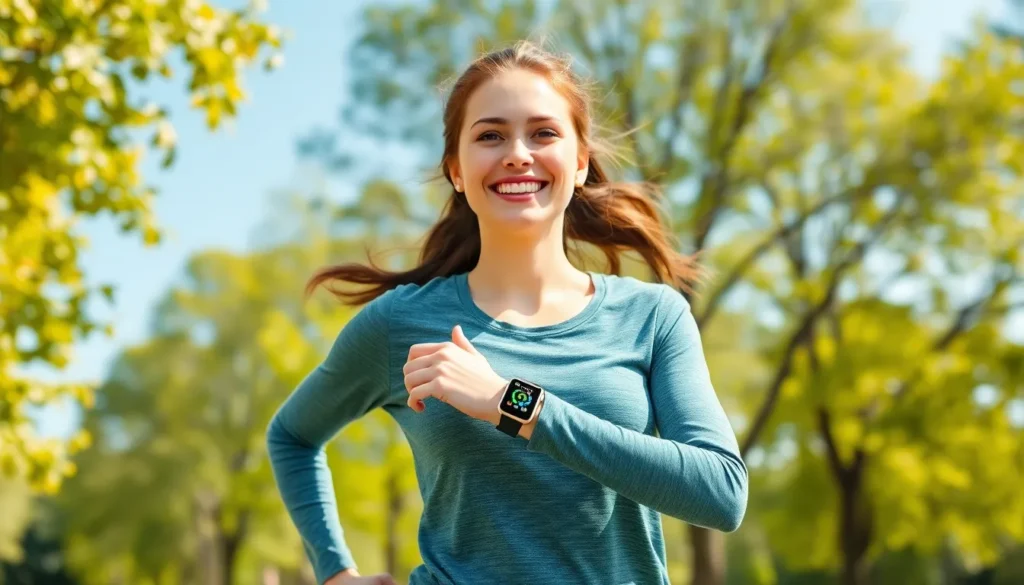Table of Contents
ToggleIn a world where time is money and notifications never stop buzzing, smartwatches have become the ultimate multitasking sidekick. Gone are the days of simply telling time; these sleek gadgets are now fashion statements, fitness coaches, and personal assistants all rolled into one. Who knew your wrist could do so much more than just hold a watch?
Overview of Smartwatches
Smartwatches serve multiple functions beyond timekeeping. They integrate features like fitness tracking, health monitoring, and communication tools. Many individuals find them essential for managing daily tasks. Notifications from smartphones enhance connectivity, allowing users to stay updated without reaching for their devices.
Fitness tracking capabilities include heart rate monitoring, step counting, and GPS mapping. Users can set fitness goals and track their progress directly from their wrists. Health-related features, such as sleep tracking and blood oxygen saturation monitoring, offer insights into overall well-being.
Smartwatch designs vary widely, catering to different preferences and styles. Some models emphasize elegance, while others focus on ruggedness for outdoor activities. Many brands, including Apple, Samsung, and Garmin, provide an array of aesthetic choices and functionalities.
Battery life plays a crucial role in user experience. Most smartwatches last between one and two days before needing a recharge. Advanced models may offer longer battery life through energy-efficient technology.
Compatibility with various operating systems enhances versatility. Smartwatches often support both Android and iOS devices, providing broader user accessibility. This cross-functionality allows individuals to select a smartwatch that best fits their existing technology ecosystem.
Finally, app ecosystems greatly expand smartwatch functionalities. Users access various applications tailored for productivity, leisure, and health management. This adaptability makes smartwatches an indispensable accessory in modern life.
Key Features of Smartwatches

Smartwatches offer an array of features that enhance daily life, making them indispensable tools for many users. These devices excel in health and fitness tracking, connectivity, and compatibility, catering to diverse needs.
Health and Fitness Tracking
Health and fitness tracking capabilities lead the functionalities of smartwatches. Many models provide real-time heart rate monitoring, allowing users to maintain target exercise zones. Step counting features keep users engaged by tracking daily activity goals. GPS mapping aids outdoor enthusiasts in navigating routes without needing a phone. Sleep tracking often reveals patterns, helping users improve rest quality. Blood oxygen saturation monitoring gives insights into respiratory health, supporting well-being awareness. These features collectively empower users to adopt healthier lifestyles.
Connectivity and Compatibility
Smartwatches enhance connectivity by receiving notifications directly from smartphones. This immediate access keeps users informed about calls, messages, and app alerts. Compatibility with various operating systems, including Android and iOS, broadens usability. Many smartwatches also integrate seamlessly with different apps, expanding functionalities further. Users can control music playback or manage smart home devices directly from their wrists. Strong Bluetooth and Wi-Fi connections ensure quick synchronization with smartphones, reinforcing the smartwatches’ role as personal assistants.
Popular Smartwatch Brands
Smartwatches from various brands offer unique features and benefits that cater to diverse user needs.
Apple Smartwatches
Apple smartwatches lead the market with their seamless integration into the Apple ecosystem. The Apple Watch Series provides advanced health monitoring features like ECG and blood oxygen tracking. Users appreciate the stylish design, which complements both casual and formal attire. It supports numerous third-party apps, enhancing functionality for fitness, productivity, and entertainment. Battery life typically lasts up to 18 hours, ensuring that users stay connected throughout the day.
Samsung Smartwatches
Samsung smartwatches stand out for their vibrant displays and robust health tracking capabilities. The Galaxy Watch series emphasizes a holistic approach to fitness with advanced workout tracking and sleep analysis. Users benefit from compatibility with both Android and iOS devices, allowing broader access. Additionally, these watches feature long-lasting battery life, averaging about two days with regular use. With customizable faces and bands, Samsung smartwatches also cater to various personal styles.
Garmin Smartwatches
Garmin smartwatches excel among fitness enthusiasts, offering specialized features tailored for athletes. The Forerunner and Fenix series provide detailed metrics for running, swimming, and cycling. Users benefit from GPS tracking with exceptional accuracy, catering to outdoor activities. These devices often include advanced health monitoring tools like VO2 max estimation and recovery time suggestions. Battery life for Garmin watches can extend up to two weeks, depending on usage and settings, making them reliable companions for long training sessions.
Benefits of Using Smartwatches
Smartwatches offer diverse advantages that enhance daily life. Enhanced health tracking features motivate users to lead healthier lifestyles. Real-time heart rate monitoring, step counting, and GPS mapping support fitness goals and progress tracking. Monitoring sleep quality and blood oxygen levels provides valuable insights into well-being.
Communication benefits from smartwatches make staying connected effortless. Users receive notifications for calls, messages, and app alerts without needing to check their smartphones. Those who prioritize convenience appreciate the hands-free experience.
Smartwatch compatibility with various operating systems expands accessibility. Many devices support both Android and iOS, catering to a broader range of users. Integration with apps enhances functionality, allowing users to control music and smart home devices directly from their wrists.
Design versatility attracts a variety of style preferences. Brands like Apple, Samsung, and Garmin offer options that blend fashion with technology. Users can choose from sporty to elegant designs, ensuring their smartwatch complements personal aesthetics.
Battery life remains an important consideration. Most smartwatches operate between one to two days on a single charge, but advanced models may last longer due to energy-efficient technology. Users focused on longevity can select devices that cater to their specific needs.
Smartwatch ecosystems significantly expand their utility. Access to third-party apps enriches user experience, enabling customization and additional functions. Individuals frequently discover new tools that align with their lifestyles and interests.
Enhanced connectivity, advanced health features, diverse styles, and robust app ecosystems make smartwatches indispensable in modern life. Users reap the benefits of these multifunctional devices, seamlessly integrating them into daily routines.
Limitations of Smartwatches
Smartwatches face specific limitations that may affect user experience. Battery life remains a significant concern, with many models lasting just one to two days before requiring a recharge. Users often find themselves needing to charge their devices frequently, which disrupts functionality.
Pricing also influences accessibility. Smartwatches can range from $100 to over $1,000, which may deter potential buyers from investing in the technology.
Fitness tracking features’ accuracy can vary among models. While some devices excel in monitoring heart rate and steps, others may present inconsistencies, leading to unreliable health data.
App compatibility poses another challenge. Users may discover that not all applications are available on all smartwatch platforms, limiting functionality for specific niches.
Durability is a critical factor that affects long-term use. Many smartwatches do not withstand extreme conditions, such as intense workouts or exposure to water, which can cause damage or malfunctions.
Screen size presents an issue for some users. Smaller displays may hinder usability, making it challenging to read notifications or navigate apps comfortably.
Limited storage capacity restricts users from downloading multiple apps or storing a significant amount of data. This limitation can be frustrating for individuals who rely heavily on their smartwatches for various functions.
Finally, user interfaces can vary in complexity. Some smartwatches require a learning curve, which may frustrate users new to the technology. Each of these limitations should be considered when selecting a smartwatch that best meets individual needs.
Smartwatches have undeniably transformed how people manage their daily lives. They offer a unique blend of functionality and style that appeals to a broad audience. With features ranging from health monitoring to seamless connectivity, these devices cater to both tech enthusiasts and casual users alike.
While the advantages are clear, potential buyers should remain mindful of the limitations. Battery life accuracy of fitness tracking and pricing can vary significantly across models. By carefully considering these factors individuals can choose a smartwatch that not only fits their lifestyle but also enhances their overall well-being. As technology continues to evolve smartwatches will likely play an even more integral role in everyday life.




